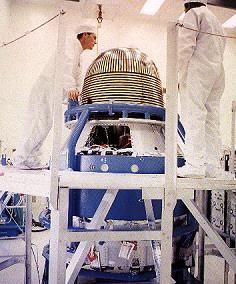Engineering:Biosatellite 3
 Biosatellite 3 satellite. | |
| Mission type | Bioscience |
|---|---|
| Operator | NASA / ARC |
| COSPAR ID | 1969-056A |
| SATCAT no. | 4000[1] |
| Mission duration | 8.8 days |
| Spacecraft properties | |
| Manufacturer | General Electric[2] |
| Launch mass | 1,546 kilograms (3,408 lb) |
| Start of mission | |
| Launch date | 29 June 1969, 03:15:59 UTC[3] |
| Rocket | Delta N 539/D70 |
| Launch site | Cape Canaveral Air Force Station LC-17A |
| End of mission | |
| Landing date | 7 July 1969 |
| Landing site | Oahu, Hawaii, USA |
| Orbital parameters | |
| Reference system | Geocentric |
| Regime | Low Earth |
| Eccentricity | 0.00144[4] |
| Perigee altitude | 221 kilometers (137 mi)[4] |
| Apogee altitude | 240 kilometers (150 mi)[4] |
| Inclination | 33.5º[4] |
| Period | 92 minutes[4] |
Biosatellite 3, also known as Biosat 3 and Biosatellite D,[5] was a third and final mission in the Biosatellite program. It was launched on a Delta-N rocket from Cape Canaveral Air Force Station on June 29, 1969,
The intent had been to fly a 6-kg male Southern pig-tailed macaque (Macaca nemestrina) named "Bonny" in low Earth orbit for 30 days. However, after only 8.8 days in orbit, the mission was terminated because of the subject's deteriorating health. High development costs were a strong incentive for maximising the scientific return from the mission. Because of this, the scientific goals had become exceedingly ambitious over time, and a great many measurements were conducted on the single research subject flown. Although the mission was highly successful from a technical standpoint, the science results were apparently compromised.[6] Bonny, dubbed an "astromonk" by the American press (as opposed to the chimpanzees from earlier American missions who were nicknamed "chimponauts") died on 8 July, one day after the biological capsule's successful recovery from the Pacific.[7]
Despite failing its scientific agenda, Biosatellite 3 was influential in shaping the life sciences flight experiment program, pointing to the need for centralised management, realistic goals and substantial pre-flight experiment verification testing. The mission objective was to investigate the effect of space flight on brain states, behavioural performance, cardiovascular status, fluid and electrolyte balance, and metabolic state.[4]
Experiments
- Determination of Bone Mineral Loss during Prolonged Weightlessness
- Effects of Prolonged Space Flight on Brain Functions and Performance[4]
See also
- Biosatellite 2
- Bion program
References
- ↑ BIOSAT 3. n2yo.com. Retrieved 14 June 2018.
- ↑ Gunter Dirk Krebs Biosat 1, 2, 3 (Bios 1, 2, 3). Gunter's Space Page. Retrieved 14 June 2018.
- ↑ Jonathan McDowell. Launch Log. Jonathan's Space Page. Retrieved 2018-06-14.
- ↑ 4.0 4.1 4.2 4.3 4.4 4.5 4.6 "Mission information: Biosatellite III". NASA. https://lsda.jsc.nasa.gov/scripts/mission/miss.aspx?mis_index=56. Retrieved 25 May 2016.
 This article incorporates text from this source, which is in the public domain.
This article incorporates text from this source, which is in the public domain.
- ↑ Antonín Vítek 1969-056A - Biosatellite 3. Katalog družic (in Czech). Retrieved 14 June 2018
- ↑ Mark Wade Biosatellite 3. Encyclopedia Astronautica. Retrieved 14 June 2018.
- ↑ "Astromonk Dies After Return", Pittsburgh Press, July 8, 1969, p1
 |

